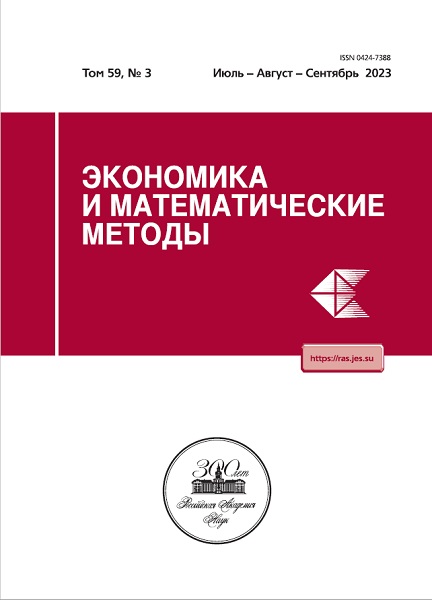Modern and promising opportunities to improve the economic efficiency of grain farming in Russia.
- 作者: Denisov V.I.1
-
隶属关系:
- CEMI RAS
- 期: 卷 59, 编号 3 (2023)
- 页面: 91-99
- 栏目: Articles
- URL: https://jdigitaldiagnostics.com/0424-7388/article/view/653328
- DOI: https://doi.org/10.31857/S042473880023371-7
- ID: 653328
如何引用文章
详细
The article evaluates, according to the criterion of maximizing national economic efficiency, alternative directions for the development of grain production and export known among agricultural scientists; significant difficulties in the functioning of the production of grain, livestock products and their supply to foreign markets in the changed external economic conditions are shown. In this regard, the well-known concepts of developing grain exports and increasing its consumption in animal husbandry as fodder are assessed in a new way, taking into account the likely decrease in the output of final products due to the limited access of the Russian agricultural industry to the use of high-performance efficient technologies in all its divisions, including grain farming.In contrast to the well-known arguments that take into account the individual pros and cons of different areas of development of the grain subcomplex of the agro-industrial complex, the article proposes the principle and tools for their clear quantitative measurement using methods of economic and mathematical modeling. It suggests both the complete acceptance or rejection of one of the directions, and their optimal ratio.
参考
- Алтухов Э. Ш. Состояние рынка зерна государств-участников СНГ // АПК. Экономика, управление. 2016. №2. С. 49-63.Гумеров Р. Р. Российский зерновой экспорт. Не повторять ошибок прошлого // ЭКО. 2017. №1. С. 5-19.Дасковский В., Кисилёв В. К программе оптимизации организационной структуры народного хозяйства // Экономист. 2016. №7. С. 3-20.Крылатых Э. Н., Белова Т. Н. Экспорт российского зерна в контексте формирования региональной экономической политики // Экономика региона. 2018, т. 14 (3). С. 778-790.Назаренко В. И. Продовольственная безопасность // М.: Памятники исторической мысли. 2014. 284 с.Назаренко В. И. Мировое продовольственное хозяйство // М.: Издательство РГАУ-МСХА. 2011. 273 с.Назаренко В. И. Мировое сельское хозяйство и Россия // Екатеринбург. Издательство Уральской с.х. академии. 2010. 353 с.Олин Б. Межрегиональная и международная торговля. – М.: Дело, 2004. 416 с.Самыгин Д. Ю., Барышников Н. Г., Мизюркина Л. А. Проектная модель развития аграрной экономики. Продовольственный аспект // Экономика региона. 2017 т. 13, №2. С. 591-603.Фальцман В. Кризис ВЭД России. Пути преодоления // Мировая экономика и международные отношения. 2017. №5. С. 57-66.Bobylev S. N., Kudryavtseva O. V., Yakovleva Ye. Yu. Regional priorities of green economy // Экономика региона. 2015. №2. С. 148-160.Gataulina E., Hockmann H., Strokov A. Production risk, technology and market access in different organizational forms: evidence from Tatarstan and Oryol // Journal of International Agriculture. 2014. Vol. 53. №4. P. 293-318. Liefert W. M., Serova E., Liefert V. The growing importance of the former USSR countries in World agricultural markets // Agricultural Economics. 2010. Vol. 41. №1. P. 65-71.Svetlov N. M. How to withstand uncertainty in Russian wheat market // News of the Timiryasev Agricultural Academy. 2016. №6. P. 108-129. Saraykin V., Yanbykh R., Uzun V. Assessing the potential for Russian grain exports: a special focus on the prospective cultivation of abandoned land // The Eurasian wheat belt and regional aspects. IPTS JRC: Seville. 2017. 318 p.Uzun V. Ya., Loginova D. A. Russian food embargo: minor losses in western counties // Russian Economic Developments. 2016. №9. P. 32-37.Uzun V., Lerman Z. Outcomes of agrarian reform in Russia // Keyzer M., Merbis M. (Eds). The Eurasian Wheat Belt and Food Security: Global and Regional Aspects. Seville: IPTS JRC, 2017. P. 81-101.
补充文件








